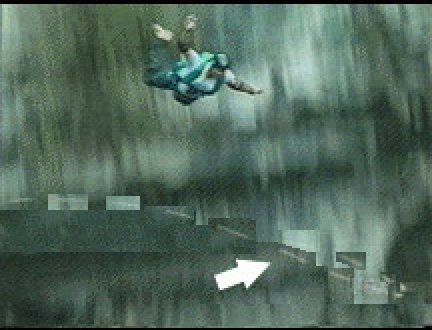The following images were taken from Jose Escamilla's Rods Web site in March of 2000. (They have since been removed.) I believe these are all of the images on Escamilla's site, at that time, that show a flight sequence well enough to compare the "rod's" location in each frame. For each, the flight sequence has been composited into a single picture by cutting and pasting the "rods" onto one frame. (Enough detail from each frame was cut to allow proper alignment.)For all except two pictures, a very interesting pattern emerges: The "rods" all appear to be moving at a rate of about twice their own length per video frame! Thus, successive images are about one rod-length apart, despite the different conditions and (presumably) different distances and different sizes of the "rods".
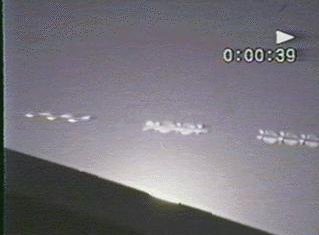
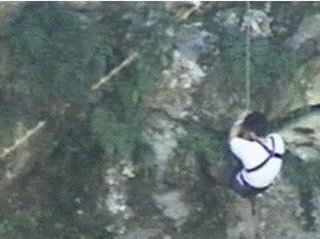
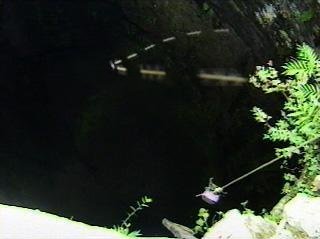
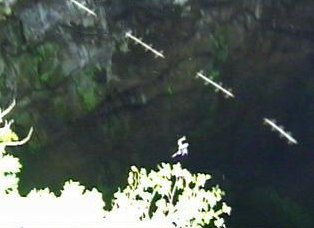
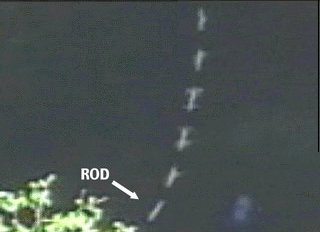
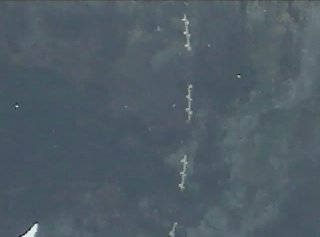
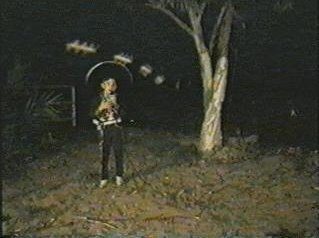
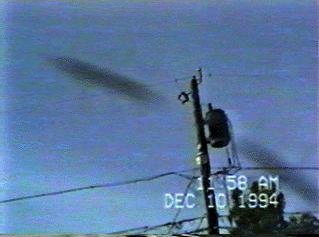
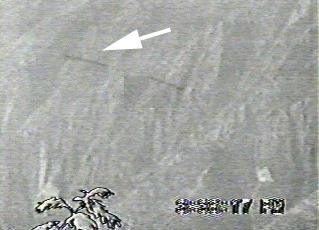
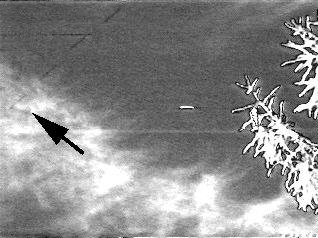
In the following picture, which is captioned on Escamilla's site as "60 fields per second" (a frame is composed of two fields, so NTSC is about 60 fields per second), the "rod" is moving about one length per field (with some overlap).
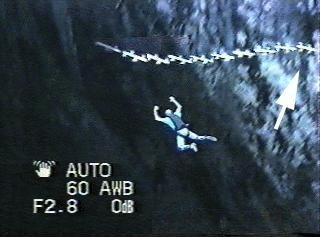
In the following picture, the "rod" is moving at a speed of precisely 3-1/3 lengths per frame. This breaks the rule of "two rod lengths per frame" shown above, but in fact the difference appears to be highly significant, as explained below.
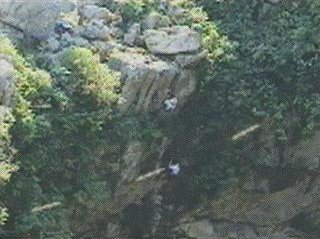
According to Escamilla, the "rods" in the pictures are cylindrical animals moving at incredibly high speed, "frozen" in the pictures by high-speed exposures. But one implication of the "two rod lengths per frame" correlation shown in the pictures above is that, since the NTSC video format is about 30 frames per second, a one-foot-long "rod" would only be flying at a speed of about 41 MPH, which makes it hard to understand why they are never seen with the naked eye. A bug flying at 41 MPH, for example, is not very hard to spot and to recognize as a bug. (And it's hard to be sure that any "rods" are even as long as one foot, since it's generally impossible to tell how far away they are in a 2D image.)The NTSC video format frame is actually composed of two "interlaced" fields, which are the alternating scan lines of the full frame. Each field is captured sequentially, and then also "drawn" on the screen sequentially when the video is viewed, so each field represents about 1/60th second of action. This is why the slowest shutter speed in NTSC camcorders is also 1/60 second: it's the case where the "shutter is open" for the full field capture time. (Actually, CCD camcorders don't have mechanical shutters controlling the exposures; the light-collection time is controlled electronically, but it's still commonly called the "shutter speed.") The PAL video format used in many countries is similar, except that it uses 25 frames -- 50 fields -- per second, so the slowest field exposure time is 1/50th second.
This understanding of video formats suggests an alternative explanation for the "two rod lengths per frame" pattern seen in Escamilla's videos. If any more-or-less spherical object is moving past a camera that's shooting 60 sequential fields per second, and each field is exposed for 1/60th second, then the motion blur across the sequential fields will simply be a continuous streak, because the camera is seeing the entire flight path. This continuous streak will be produced regardless of the speed of the object: The only difference will be that faster moving objects will make longer streaks in each field, but the successive streaks will still be end-to-end. But notice now, if you take only one field from each frame -- which is what many VCRs actually do if you pause the video and then use the single-frame advance -- you will get exactly the same pattern as that seen in most of Escamilla's images: You will get "rods" separated by gaps of the same length as the "rods." The gaps are simply where the "rods" would be in the unseen fields.
For example, at 1/60 second exposure, an insect flying about 40 MPH can look like a foot-long "rod" in each NTSC field. Then, if only one field from each frame is extracted and composited into a single image, there will also be one-foot gaps between successive "rod" images, exactly like the pattern seen in Escamilla's images above. The speed doesn't really matter: An insect flying half that speed will produce streaks half that length, but with exactly the same "rod-gap-rod" pattern in successive images.
Moreover, at 1/100 second exposure, which is the next step up in most NTSC camcorders, the "rod" produced by the motion blur will appear to be moving precisely 3-1/3 "rod lengths" per frame, exactly like the last picture shown above! So, Escamilla's apparent exception actually appears to prove the rule.
The following pictures were composited from tests in which I tossed small balls of aluminum foil in front of the camera. (The balls are about 1/8 inch in diameter and they are tossed about a foot in front of the lens.) The exposure was forced to 1/60 second in the first picture, and to 1/100 in the second picture. (The box in the center is an "aiming" box generated in the camera.)
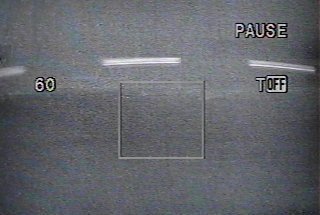
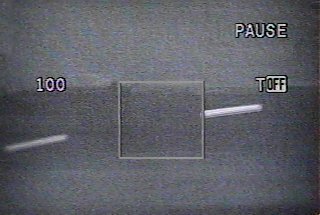
For a better comparison to Escamilla's "rod" pictures above, the following two pictures are of a white bug shot outdoors at 1/60. Both pictures were made from the same set of frames, but one was composited using just the first field from each frame, and the other is just the second fields. (Notice that if the two sets of fields were composited together, the bug would be making a continuous streak.) Again we see the "two lengths per frame" and in this picture we can also see an undulating or "sinusoidal" pattern of the beating wings, which is also seen in many "rod" pictures.
In this set of pictures, which were again composited from the two sets of fields for the same frames, a large bug flew by within a few feet of the camera, and the large beating wings have been captured fairly well in the setting sunlight. (In this picture and the one above, the sun is behind the bug to the left of the frame, and it is being blocked from directly entering the camera lens, which is a technique commonly used for "rod" pictures, e.g. the top picture on this page).

Obviously, these images and the ones at the link below resemble Escamilla's "rods", but the significant principle for understanding why Escamilla's "rods" are most likely motion-blurred bugs is the apparent "rod" speed of two lengths per frame, which is seen in these bug pictures and in Escamilla's pictures. It is caused by the fact that each "rod" is simply a continuous blur captured in one field during the 1/60 exposure, and each gap is a section of that same continuous blur that was captured by the alternate field in the same frame, and which is not usually shown. (It appears to be shown, however, in one of Escamilla's sequences above: the one in which the "rod" forms a continuous streak!) The probability that this pattern could be pure coincidence is so remote that it boggles the mind.
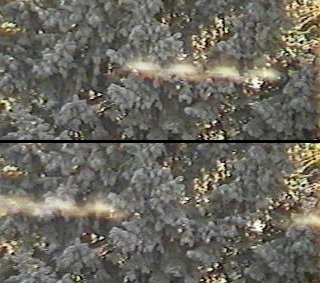
More Flying Bug Pictures
Escamilla's site also has a "rod" that was videographed by Fox TV. In this series, the camera was following a skydiver, so the images show the cliff face behind the skydiver as blurred. (Although Escamilla calls this a "high speed" shot, apparently he is referring to the estimated 95 MPH speed of the skydiver, since the cliff face blurring implies a slow shutter setting.) The picture on the left below is an attempt to composite the "rod" relative to identifiable features on the cliff face. Using the cliff as a reference, the "rod" appears to be falling like a bomb, slowly rotating downward as it falls, but after the "rod" turns (which is not shown) it would appear to rotate upward as it flew back toward the skydiver. The picture on the right is an attempt to composite the "rod" relative to the skydiver's helmet. Using the skydiver as a reference, the "rod" appears to "skid" unnaturally across the frame before making the turn. The Incredible Skydiving Rod
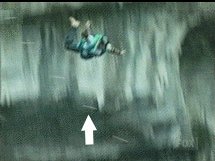
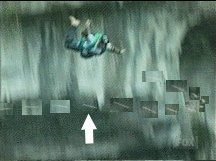
In the following picture, the "rod" images have been composited relative to the frame itself, specifically the lower corners of each frame. Using the frame (i.e. the camera) as a reference, the "rod" appears to follow a smooth flight path, and once again we see the "rod" moving two lengths per frame!
It would seem that the most reasonable explanation for this picture is that it's just a very small bug that flying very near the camera lens -- so close that the rotation of the camera doesn't have much effect on the smooth appearance of the flight path.
Comments or questions about this page? Contact Sol Please see these pages for more evidence:
